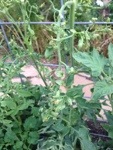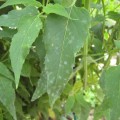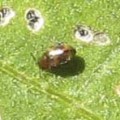Curly Top is an insect-vectored viral disease spread by beet leafhoppers, which affects many plants. The beet leafhopper loves warm and dry weather, so that’s when infections are most severe.
Species & Taxonomy
- Kingdom:
- Phylum:
- Class:
- Order:
- Family:
- Genus Species:
Plants Affected
- beet family crops: beets, spinach, swiss chard
- tomato family crops: tomatoes, potatoes, tomatillos, eggplant, ground cherries, peppers
- beans
- squash family crops: squash, zucchini, cucumbers, melons, gourds, pumpkins
- a wide range of herbaceous plants are affected to a lesser degree
Plants Unaffected
Geographical Range
- western US
- southern Canada
Signs & Symptoms
Symptoms of curly top virus can resemble tomato spotted wilt, which is a disease spread by thrips
Whole Plant
- distorted growth
- color changes to yellow (only part of the plant)
- stunting, although my tomatoes, which definitely had the virus shot up, with a large amount of space between leaflet stems
- seedlings will die fairly quickly
- tomatoes: plant growth stops
Leaves
- beet leaves appear small, twisted, and curled or crinkled
- spinach leaves yellow, deformed and stunted; deformed leaves may die; to differentiate between curly top and mosaic virus, if older leaves are also mottled, then it’s mosaic virus (also called blight or yellows) and not curly top
- in tomatoes:
- leaves become thick and crisp, and veins may turn purple
- tomato leaves twist and curl upward, becoming stiff and leathery; eventually turning yellow then brown; leaf stems bend downward
- upper leaflets roll and develop a purplish color, especially along the veins
- tomato leaf veins turn purple and bronze, although this could also be caused by phosphorous deficiency
- leaves curl upward and feel thick, leathery, or brittle; although, some varieties characteristically roll leaves upward when they are perfectly healthy; leafroll can also be caused by wet conditions – symptoms will disappear when the soil dries out
- in squash, the older leaves will be yellowed, but the younger ones are very dark green
- beans will produce tufts of abnormal leaves: stunted and crinkled
Flowers
- beans will flower prematurely
Fruit
- Tomatoes:
- Young tomato fruits of infected plants will be dull and wrinkled
- tomato fruit set stops
- if fruit is already present, it ripens prematurely
- beans, because of the premature flowering will produce a poor harvest
Roots
- in beets, infected plant roots are deformed and covered with matted side roots; also described as “hairy side roots”
- beets have woody flesh
How to Positively Identify
Differentiate from tomato spotted wilt:
- TSW always shows bronzing of the leaves or small dark spots or flecks
- TSW causes fruit to show concentric rings on both green and red tomatoes
Treatment
There is no treatment for plants once they are infected. Plants infected with curly top virus should be removed and composted before the virus is spread by the leafhoppers.
Prevention & Control
The best way to prevent or control the spread of curly top virus is to control leafhopper populations. See full article on leafhoppers for more info.
Cultural Controls:
Temperature & Humidity:
- leafhoppers flourish in warm dry weather, so shading and misting helps during dry spells to prevent leafhoppers from flourishing
- leafhoppers like to feed in sunny spots, so plant susceptible plants in areas that receive light shade
- Hot, dry springs with predominantly southwest winds usually lead to leafhopper problems – at least in western Colorado
Barriers:
- cover smaller plants with row covers at planting to protect plants from leafhoppers, but they need to be removed when flowering starts so that pollinators can get to them
- cover tomato cages with fine netting which provides light shade; the netting also may block the leafhoppers; remove netting when fruit begins developing
Mulching & Cultivation Practices:
- since the curly top virus survives in weeds and ornamental plants, stay on top of weeding and monitoring the ornamentals for disease
- weed the garden thoroughly in the fall
- Control weeds that are common hosts for the virus, especially:
- lambsquarter
- halogeton
- Russian thistle, all thistles
- greasewood
- Atriplex (four wing saltbush)
- Mustards
- plantain
- tumbleweed
- choose varieties that are resistant to beet curly top virus
- plant beets and spinach early in the spring to beat the arrival of infected leafhoppers
- leafhoppers like to feed in sunny spots, so plant susceptible plants in areas that receive light shade
- plant beets away from tomato family or squash family crops
- the beet leafhopper avoids dense plants, so densely planted crops are less attractive to the pest
- Since the beet leafhopper is only a transitory pest in tomatoes, it’s important to keep weeds and other preferred plants away from your tomato plants, so they don’t stick around
Natural Enemies & Biological Controls
Insects:
Animals:
Reptiles:
Traps
Sprays & Dusts
- No chemical controls are effective




